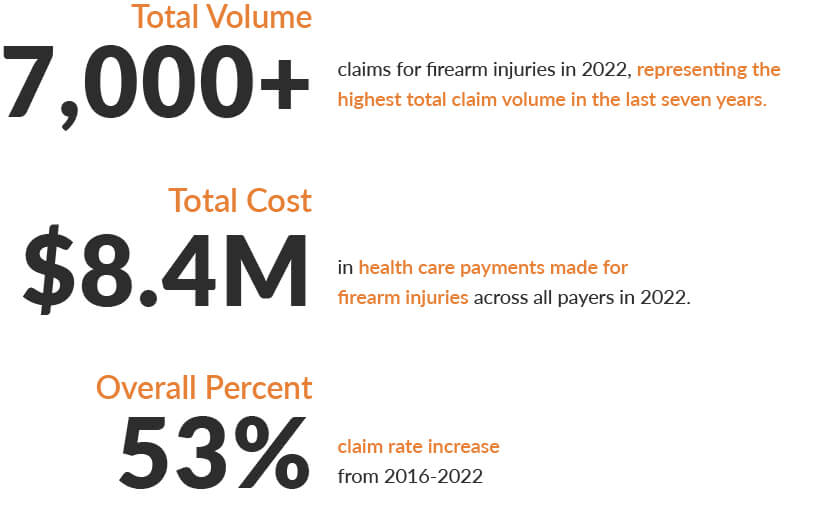Unintentional Injuries Among Children Have Increased Significantly
DENVER, CO [May 9th, 2024] – A new analysis of Colorado All Payer Claims Database (CO APCD) data from 2016-2022 shows firearm-related injuries in Colorado hit a peak in 2022, with over 7,000 health care claims and $8.4 million in health care costs. Results revealed that while adults had more total claims for firearm injuries, the percent increase in the rate of claims since 2016 was highest for children. Unintentional injuries were the most common type of firearm injuries across all age groups, but unintentional injuries rose most substantially for children (143%) during the time period evaluated.
Results of this analysis reinforce a recent Colorado Sun analysis of Colorado Department of Public Health and Environment data indicating that firearm related violence in Colorado hit a 40-year high in 2021. It also adds credence to the American Public Health Association and the Centers for Disease Control recognition of firearm injuries and deaths as a significant public health crisis.
The analysis showed that from 2016-2022 the rate of firearm injury claims across all ages in Colorado increased 53%. Further investigation revealed that across demographics, adults, men, rural communities, and people covered by Medicaid had the highest rates of claims for firearm injuries, although children and females had the highest percent rate increases over the time period.
Key Findings in 2022:
- In 2022 there were over 7,000 firearm-related claims resulting in $8.4M in health care costs.
- Unintentional injuries (e.g., accidental discharges) accounted for the vast majority (72%) of claims while injuries from assaults made up the majority of the remaining claims (17%).
Demographic Data and Trends (2016-2022)
Adults vs. Children/Youth:
-
- Adults had the majority (88%) of firearm injury claims.
- For children and youth, the rate of firearm injuries increased across all categories (120%), with claims for unintentional (143%) and undetermined (111%) injuries increasing the most.
Men vs. Women:
- Men had significantly more firearm injury claims than women, with rates three times higher for all injury types, four times higher for unintentional injuries, three times higher for assault, and two-and-a-half times higher for self-harm.
- The rate of firearm injuries increased across nearly all types for both males and females with the largest percent increase being for females with undetermined intent (233%) followed by assault (60%).
Rural vs. Urban:
- Rural areas consistently had higher rates of self-harm and assault related injuries, with spikes in self-harm related claims in 2021 that were 25 times the rate of urban counties. In 2020, assault-related claims reached a peak for rural communities with rates three times urban communities.
- Rural counties had 25% higher costs per claims to treat firearm injuries than urban communities.
By Payer Type:
- Medicaid recipients experienced higher rates of firearm injuries than people with other types of insurance, with rates 12.5 times more than those with commercial insurance.
"This analysis highlights a concerning trend in firearm-related injuries across Colorado," said Kristin Paulson, President and CEO at CIVHC. "These results demonstrate the critical need for continued focus on comprehensive public health, education, and community-tailored initiatives aimed at addressing and preventing firearm violence, particularly violence involving children, who are seeing a marked rise in firearm-related injuries."
Data in this recent analysis can be used to understand the public health impact of firearm-related violence and shape effective prevention strategies. Policy makers, non-profits, communities, and others can harness this information in conjunction with other firearm data available in Colorado to measure the impact of work currently being done to address firearm violence and deaths.
Important notes to consider when viewing the results of this analysis:
- The CO APCD data does not contain death record information. Health care services to treat firearm injuries in this analysis may or may not have resulted in a death.
- Data in this analysis does not include firearm injuries that did not result in a health care visit, was not paid for through a claim, or ended in immediate death.
Visit our website to explore the analysis and view the Firearm Injury Infographic and download the associated Excel Data.
If you or someone you know needs immediate support or are having suicidal thoughts, contact the Colorado Crisis and Support Line: Call 1-844-493-TALK (8255) or text "TALK" to 38255.
To learn about some of the ongoing efforts to reduce firearm violence in Colorado, click on the resources below:
